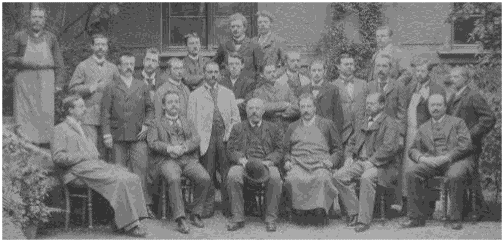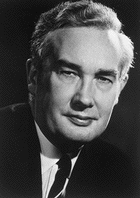Problem Set 2
Chapter 3, Alkanes
Due: Monday, February 4, 2013
The Baeyer Laboratory,
Munich, 1893 (This photograph is in
the hallway across from 110 SCL) Adolf
von Baeyer (1835-1917); Nobel
Prize 1905. (center, seated with derby), who was a student
of Kekulé, succeeded Liebig at Munich. In the
photograph (second row; third from right) is
Henry Lord
Wheeler (1867-1914); Yale Faculty
1896-1911. As was the custom in the 19th century,
many Americans, such as Wheeler, did advanced study in
chemistry in Europe.
Karl
Gimmig is the laboratory assistant. (The only person wearing an
apron and no tie; upper left.) In 1885, as an addendum to a paper on
acetylenic compounds, Baeyer proposed that cyclopentane was
the least
strained of the cycloalkanes.
While he accepted the idea that the carbon atoms in
cycloalkanes were tetrahedral, he treated the cycloalkanes
as though they were flat. He argued that there is only one
cyclohexane carboxylic acid, not two (axial and equatorial)
as was predicted by a chair cyclohexane. Sir Derek H. R. Barton
(1918-1998) 1969 Nobel
Prize with Odd Hassel for their
work on conformational analysis For a video of Barton talking about
conformational analysis, click
here.
Cyclohexane
in the chair conformation


a. Work through How to Draw Cyclohexanes (PowerPoint)
b. The Conformation Module in the Study Aids will give you a good overview of the subject of conformation.
c. View The Evolution of Formulas and Structure in Organic Chemistry During the 19th Century (PowerPoint).
| 1. Redraw (line angle formula) and name (IUPAC) the hydrocarbon located on the right. [What if there are two different longest chains? Check here.] For a static view, click here. |
|---|
2. Compound A (MW=170.24), a 1,4-disubstituted cyclohexane soluble in aqueous sodium hydroxide,
has the following composition: C, 70.55%; H, 10.66%. The
difference in conformational energy for the two chair conformations
of A is 0.7 kcal/mol. Using the A-value data (Energy Differences Between ..... Cyclohexanes), determine the
structure of A. Illustrate and explain. What is the
conformational energy difference for the stereoisomer of A,
---namely A'. Explain and illustrate. Show the chair
comformations of A and A' with the appropriate
equilibrium arrows to illustrate the major and minor conformations.
Label each conformation with its energy.
3. Predict the heat of formation of 2-methyloctane using the data
presented here.
Explain.
4. Examine the heats of formation of the four acyclic octanes listed in the
heats
of formation tables.
a)What trend do you notice?
b) Draw a diagram that shows the heat of formation and heat of combustion of the two extreme cases: n-octane and 2,2,3,3-tetramethylbutane. Show calculations.
c) Consider the cyclic octanes trans- and cis-1,4-dimethylcyclohexane in the heats of formation tables. Explain and illustrate their difference in heats of formation.
5. a) Calculate the heat of combustion of cyclobutane using the
data (ΔHfo of cyclobutane,
CO2 and H2O) in the heats
of formation tables.
Compare your value with
the value in Table 3-5 in your text.
b) Calculate the strain energy in cyclobutane given the heat of
combustion of cyclohexane (Table 3-5 in your text) and the knowledge
that cyclohexane is strain-free.
6. Draw Newman projections for the eclipsed and staggered
conformations of 2,3-dimethylbutane viewed along the
C2-C3 axis. Calculate the energy of each
conformation, both staggered and eclipsed.